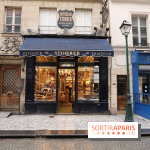To delve into the history of Le Rocher de Cancale is to embark on a journey through time, at the heart of the culinary and cultural evolution of Paris. Since its foundation in 1804 by Alexis Belaine, this restaurant has become an emblematic landmark on Rue Montorgueil, a district historically linked to the trade in fresh fish from the Normandy and Picardy coasts. Le Rocher de Cancale, with its specialties of fried oysters or oysters served "en coquille", quickly captured the attention of Parisian society, becoming an essential meeting place after the theater.
Did you know that in the 19th century, millions ofoysters were eaten every year in Paris? Indeed, at the time, Paris was reputed to gobble up nearly 17 million of these mollusks annually, confirming its status as a city of refined tastes. Among the places prized by connoisseurs was the famous Rocher de Cancale. This name evoked an emblematic place for the capital's gourmets, even though it was neither located on a rock nor in Cancale, but in the heart of Paris, in the vibrant Les Halles district.
The restaurant has attracted such illustrious figures as Alexandre Dumas, Théophile Gautier and Eugène Sue. Le Rocher de Cancale has also left its mark on literature, having been immortalized by Balzac in La Comédie Humaine, where the author himself enjoyed the oysters. This literary fame has greatly contributed to the restaurant's prestige as an essential part of Paris's gastronomic, cultural and historical heritage, to the point of being listed as a historic monument in 1997.
Laurent Grimod de La Reynière, a renowned gastronomic critic of the time, organized his famous "Caveau dinners" here, during which a selected panel of judges tasted and evaluated the restaurateurs' dishes. It was here that " sole normande " was created by chef Langlais in 1837.
The first "Au Rocher de Cancale" was born in 1804 at 59 rue Montorgueil, taking advantage of the strategic location, an effervescent trading place and a privileged meeting point for oyster farmers. In the twilight of the First Empire, Balaine, the original owner, sold the Rocher de Cancale to a man named Borel, who went bankrupt in 1846. After a brief period of closure and a one-year interlude on rue Richelieu, the restaurant rose from the ashes, this time across the street from its original site. The current site can now be seen at 78 rue Richelieu.
The restaurant's facade, restored to an elegant pastel blue punctuated by Louis XVI-style carved woodwork, and the interior frescoes by Gavarni, bear witness to the place's artistic and gastronomic heritage. These elements contribute to creating a unique atmosphere.
The uniqueness of Le Rocher de Cancale lies not only in its historically rich setting, but also in its culinary offerings. The menu at Le Rocher de Can cale reflects this tradition, while adapting to contemporary tastes. Starters, such as ravioles de Royan or escargots de Bourgogne, are a tribute to local produce and the finesse of French cuisine. Main courses, such as roasted cod back or entrecôte with Roquefort sauce, are prepared with care, honoring culinary techniques inherited from centuries past. Desserts, from bourbon vanilla crème brulée to chocolate mi-cuit, end the meal on a note of traditional sweetness.
In short, to visit Au Rocher de Cancale is to experience a living part of Parisian history while having a good time on the plate. It's to sit where generations of gourmets have celebrated life, tasted fine food and participated in the evolution of a rich and varied culinary tradition. We invite everyone to cross the threshold of this historic place, soak up its history-laden ambience and savor each dish as a chapter in a Parisian culinary tale.
Rue Montorgueil is also home to other historic landmarks such as the Stohrer patisserie, the former Café Biard, now home to Jeffrey Cagnes' patisserie, and the Escargot d'Or restaurant , which we invite you to discover.
Read also:
L'Escargot Montorgueil, the Parisian institution still delighting, 200 years later
Located in the Halles district of Paris, L'Escargot Montorgueil showcases Burgundy snails in original recipes, and brilliantly executes the great classics of French gastronomy. [Read more]
Did you know? What is the history of the Au Planteur façade in Paris that is being debated?
Discover the Au Planteur facade in Paris, Montorgueil district, classified as a historical monument since 1984. Located at 10-12 rue des Petits-Carreaux in the 2nd district, this facade and colonial fresco is still being debated, we tell you its history. [Read more]
Stohrer, the oldest pastry shop in Paris still in business
Stohrer, the oldest Parisian pastry shop still in operation, has been offering delicious creations since 1730. Located at 51 rue Montorgueil in the 2nd arrondissement of Paris, this institution is open all year round. [Read more]
Jeffrey Cagnes patisserie, rue Montorgueil, Paris
Jeffrey Cagnes takes over rue Montorgueil! If you're a sweet tooth, a savory tooth or a chocolate lover, now's the time to discover the emblematic chef's patisserie in Paris's 2nd arrondissement, a stone's throw from Les Halles. [Read more]
Sources :
Dates and Opening Time
Starts January 6, 2025
Location
Au Rocher de Cancale
78, Rue Montorgueil
75002 Paris 2
Recommended age
For all
Instagram page
@aurocherdecancale
More information
Open every day from 8 a.m. to 2 a.m.











 L'Escargot Montorgueil, the Parisian institution still delighting, 200 years later
L'Escargot Montorgueil, the Parisian institution still delighting, 200 years later


 Did you know? What is the history of the Au Planteur façade in Paris that is being debated?
Did you know? What is the history of the Au Planteur façade in Paris that is being debated?


 Stohrer, the oldest pastry shop in Paris still in business
Stohrer, the oldest pastry shop in Paris still in business


 Jeffrey Cagnes patisserie, rue Montorgueil, Paris
Jeffrey Cagnes patisserie, rue Montorgueil, Paris














